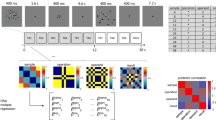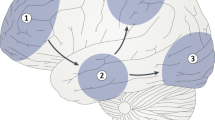Abstract
POSITRON emission tomography (PET) can be used to map brain regions that are active when a visual object (for example, a hand) is discriminated from its mirror form. Chronometric studies1á€-3 suggest that viewers 'solve' this visual shape task by mentally modelling it as a reaching task, implicitly moving their left hand into the orientation of any left-hand stimulus (and conversely for a right-hand stimulus). Here we describe an experiment in which visual and somatic processing are dissociated by presenting right hands to the left visual field and vice versa. Frontal (motor), parie- tal (somatosensory) and cerebellar (sensorimotor) regions similar to those activated by actual4,5 and imagined6á€-8 movement are strongly activated, whereas primary somatosensory and motor cortices are not. We conclude that mental imagery is realized at intermediate-to-high order, modality-specific cortical systems, but does not require primary cortex and is not constrained to the perceptual systems of the presented stimuli.
This is a preview of subscription content, access via your institution
Access options
Subscribe to this journal
Receive 51 print issues and online access
$199.00 per year
only $3.90 per issue
Buy this article
- Purchase on Springer Link
- Instant access to full article PDF
Prices may be subject to local taxes which are calculated during checkout
Similar content being viewed by others
References
Parsons, L. M. Cogn. Psych. 19, 178–241 (1987).
Parsons, L. M. J. exp. Psych. 116, 172–191 (1987).
Parsons, L. M. J. exp. Psych. 20, 709–730 (1994).
Frith, C. D., Friston, K., Liddle, P. F. & Frackowiak, R. S. J. Proc. R. Soc. 244, 241–246 (1991).
Roland, P. E., Meyer, E., Shibasaki, Y. L., Yamamoto, Y. L. & Thompson, C. J. J. Neurophysiol. 48, 467–480 (1982).
Roland, P. E., Lassen, N. A., Larsen, B. & Skinhoj, E. J. Neurophysiol. 43, 118–136 (1980).
Fox, P. T., Pardo, J. V., Petersen, S. E. & Raichle, M. E. Soc. Neurosci. Abstr. 13, 1433 (1987).
Decety, J. et al. Nature 371, 600–602 (1994).
Goldberg, M. J. & Bruce, C. J. J. Neurophysiol. 64, 489–508 (1990).
Tanji, J. Neurosci. Res. 19, 251–268 (1994).
Posner, M. I. & Petersen, S. E. A. Rev. Neurosci. 13, 25–42 (1990).
Colebatch, J. G., Deiber, M. P., Passingham, R. E., Friston, K. S. & Frackowiak, R. S. J. J. Neurophysiol. 65, 1392–1401 (1991).
Dum, R. P. & Strick, P. L. in Motor Control: Concepts and Issues (eds Humphrey, D. R. & Freund, H.-J.) 383–397 (Wiley, New York, 1991).
Andersen, R. A. in Handbook of Physiology (eds Plum, F. & Mountcastle, V. B.) 483–518 (Am. Physiol. Soc., Bethesda, Maryland, 1987).
Heilman, K. M., Watson, R. T. & Valenstein, E. in Clinical Neuropsychology (eds Heilman, K. M. & Valenstein, E.) 279–336 (Oxford University Press, New York, 1993).
Stein, J. F. in The Brain and Space (ed. Paillard, J.) 185–222 (Oxford University Press, New York, 1991).
Heilman, K. M. & Rothi, L. J. in Clinical Neuropsychology (eds Heilman, K. M. & Valenstein, E.) 141–163 (Oxford University Press, New York, 1993).
Kosslyn, S. M. et al. J. Cogn. Neurosci. 5, 263–287 (1993).
Johnson-Laird, P. N. in Foundations of Cognitive Science (ed. Posner, M. I.) 469–499 (MIT Press, Cambridge, Massachusetts, 1989).
Ungerleider, L. G. & Mishkin, M. in Analysis of Visual Behavior (eds Ingle, D. J., Goodale, M. A. & Mansfield, R. J. W.) 549–586 (MIT Press, Cambridge, Massachusetts, 1982).
Perrett, D. I., Oram, M. W., Hietanen, J. K. & Benson, P. J. in Neuropsychology of Higher Level Vision (eds Farah, M. & Ratcliff, R.) 33–61 (MIT Press, Cambridge, Massachusetts, 1994).
Gross, C. G., Rocha-Miranda, C. E. & Bender, D. B. J. Neurophysiol. 35, 96–111 (1972).
Posner, M. I. & Raichle, M. E. Images of Mind 30–31, 90–95 (Freeman, New York, 1994).
Biederman, I. in Invitation to Cognitive Science II (eds Osherson, D., Kosslyn, S. M. & Hollerbach, J. M.) 41–72 (MIT Press, Cambridge, Massachusetts, 1990).
Tarr, M. J. Psychonom. Bull. Rev. 2, 55–82 (1995).
Marr, D. Vision (Freeman, San Francisco, 1982).
Shepard, R. N. & Cooper, L. Mental Images and their Transformations. (MIT Press, Cambridge, Massachusetts, 1982).
Hinton, G. E. & Parsons, L. M. Cognition 30, 1–35 (1988).
Fox, P. T. & Mintun, M. A. J. nucl. Med. 30, 141–149 (1989).
Talairach, J. & Toumoux, P. Co-planar Stereotaxic Atlas of the Human Brain (Thieme Medical, New York, 1988).
Author information
Authors and Affiliations
Rights and permissions
About this article
Cite this article
Parsons, L., Fox, P., Downs, J. et al. Use of implicit motor imagery for visual shape discrimination as revealed by PET. Nature 375, 54–58 (1995). https://doi.org/10.1038/375054a0
Received:
Accepted:
Issue Date:
DOI: https://doi.org/10.1038/375054a0
This article is cited by
-
Atypical influence of biomechanical knowledge in Complex Regional Pain Syndrome-towards a different perspective on body representation
Scientific Reports (2023)
-
Talking with hands: body representation in British Sign Language users
Experimental Brain Research (2021)
-
The effect of handedness on mental rotation of hands: a systematic review and meta-analysis
Psychological Research (2021)
-
Performing the hand laterality judgement task does not necessarily require motor imagery
Scientific Reports (2020)
-
Automatic attribution of social coordination information to chasing scenes: evidence from mu suppression
Experimental Brain Research (2018)
Comments
By submitting a comment you agree to abide by our Terms and Community Guidelines. If you find something abusive or that does not comply with our terms or guidelines please flag it as inappropriate.



